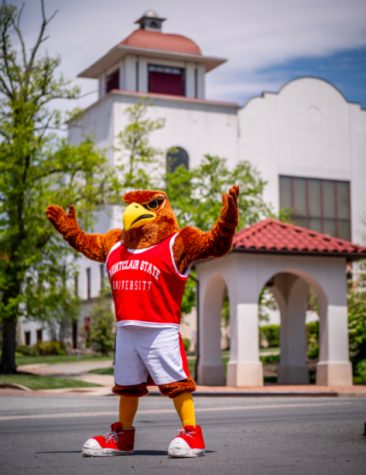Colleges remove Indian mascots
January 27, 2021
During a division III baseball championship in 1987, Montclair State University sported caps adorned with a “cartoon native character.” This event took place two years before the school switched its nickname to the Red Hawks.
In 2005, the NCAA sent out a press release banning the use of inappropriate signs or displays of racial and ethnic mascots in the NCAA colleges. Walter Harrison, Chair of the Executive committee said, “Colleges and universities may adopt any mascot that they wish, as that is an institutional matter. But, as a national association, we believe that mascots, nicknames or images deemed hostile or abusive in terms of race, ethnicity or national origin should not be visible at the championship events that we control.”

The Montclair State University mascot, Rocky the Red Hawk. In 1989, the school changed its nickname form the Indians to the Red Hawks.
Montclair State University’s first athletic logo was used from the 1920s to 1930s. On Montclair States’ athletic uniforms, it read the “Big Reds.” Then, in the 1930s the Teacher’s College at Montclair State changed its nickname to the Indians. The picture of the Indian mascot appeared on the Montclair State athletic uniforms.
“Very few students know about it because it is not something that the school talks about,” Professor of Religion at Montclair State University, Mark Clatterbuck, said.“It’s hard to find anything on the website [about the school’s former mascot].”
Later, in 1989, the athletic department at Montclair State chose to replace the Indian mascot with the Red Hawks – the birds that occupied the surrounding areas of the campus. It chose to change the mascot due to the impact it made on the Native Americans in the surrounding area.
A contest was created to replace the Indian logo with an alternative picture. Eventual winner Maureen Mcgill, a student at Montclair State, depicted a logo of a Red Hawk soaring under an “M.”
Similarly, in 1951 a bronze statuette of the Saltine Warrior, a Native American figure, was placed on the Syracuse University campus, where it stayed for many years. Many believed it to be an emblem of pride.
The origin of the Saltine Warrior was from a tale of Hoschenegada, that was later proven untrue, translated to the name of “The Salt Warrior.” The remains of the Onondaga Nation chief, Ogeekeda Hoschenegada was said to be found in the 1920s during the excavation of the Syracuse Women’s Building.
After an article was posted in a campus magazine, “The Orange Peel,” it generated attention and led to the university making the Saltine Warrior its new mascot.
Then, during the 1950s a fraternity decided to dress up as the Saltine Warrior and parade it around at a football game. In the stadium, people from the crowd shouted battle cries.
When Doug George Kanentiio, a member of the Mohawk nation and Vice President for the Hiawatha Institute of Indigenous Knowledge, visited Syracuse University, he was shocked by the use of the Saltine Warrior mascot. Then, Kanentiio had a discussion with Chancellor Melvin Eggers in 1977 about the mascot.
He agreed to take strides to remove the university’s mascot. Later, Mr. Kanentiio had a discussion with the fraternity that dressed up as the mascot in hopes of the young men understanding where he was coming from.
After 1978, the Saltine Warrior was retired as the Syracuse Mascot. The orange was known by many as the unofficial mascot of Syracuse for a period of time. As of 1995, Otto the Orange was named the Syracuse University mascot.


